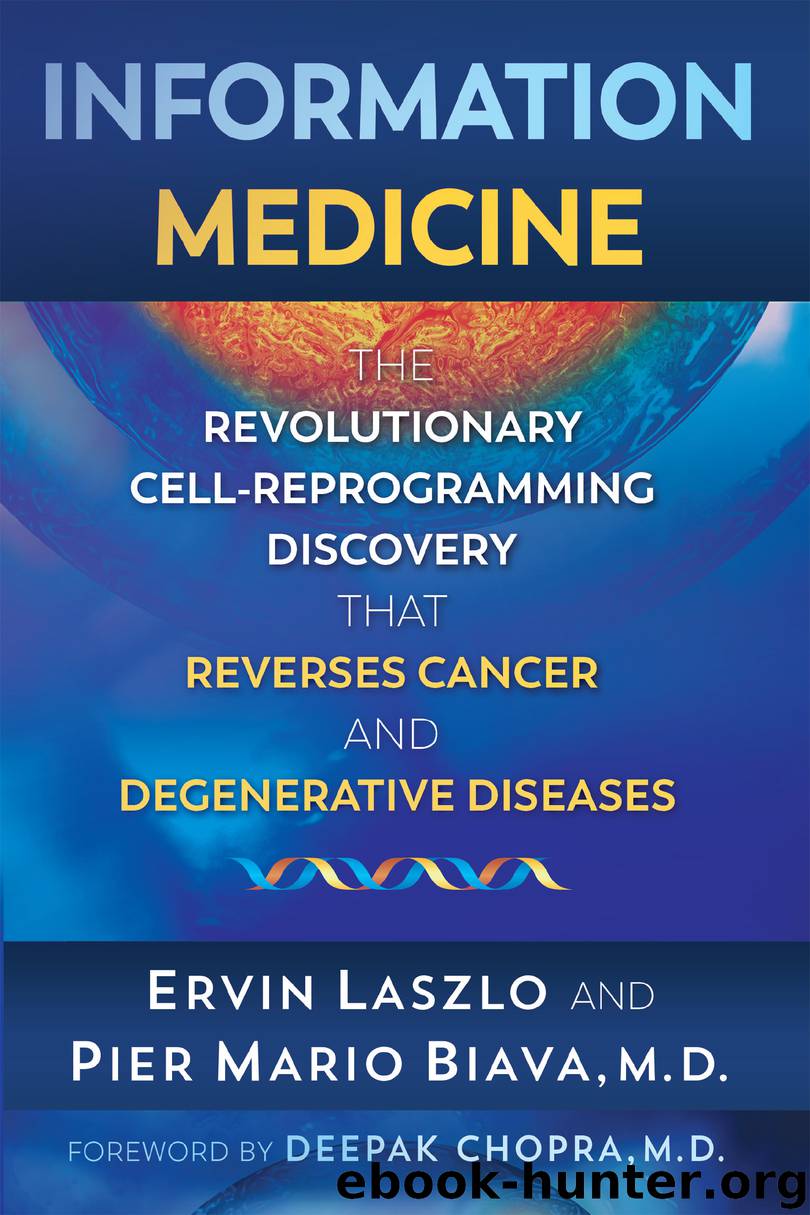Information Medicine by Ervin Laszlo

Author:Ervin Laszlo
Language: eng
Format: epub
Tags: Complementary & Alternative Therapies
Publisher: Inner Traditions/Bear & Company
Published: 2019-01-20T16:00:00+00:00
SCDSFs in Human Adipose-Derived Stem Cells (hASCs)
The possibility to address the fate of hASCs, isolated from a microfractured fat tissue obtained with a novel non-enzymatic method and device (Lipogems)30, was explored by exposing them to SCDSFs.18
SCDSFs taken during the late developmental stages (20 somites and pharyngula stages) decreased cell viability and elicited caspase-3 mediated apoptosis. This effect did not involve Bax or Bcl-2 transcription. This phenomenon has long been observed, as shown in the case of Bax-independent, caspase-3-related apoptosis induced by hepatocyte growth factor (HGF) in rat liver epithelial cells and recently confirmed in both malignant and normal cells.31
Unlike SCDSFs taken during the late developmental stages, SCDSFs taken during the early developmental stage (50 percent epiboly stage) did not induce hASC apoptosis, nor did it decrease cell viability. Indeed, SCDSFs of the early developmental stage were able to modulate the stem-cell expression of multipotency, enhancing the stemness genes Oct-4, Sox-2, and c-Myc. In addition to affecting stemness genes that maintain stem-cell identity,32 SCDSFs also elicited transcriptional activation of two major mechanisms capable of counteracting stem-cell senescence, including the gene expression of TERT, the catalytic subunit of telomerase, and the gene transcription of Bmi-1. This is a member of the Polycomb and Trithorax families of repressors which acts as essential factors for self-renewal of adult stem cells, and as a key telomerase independent repressor of cell aging.33
Thus, this study showed that human stem cell exposure to SCDSFs taken during the early developmental stage of Zebrafish embryo may represent a useful tool to enhance stem-cell expression of multipotency and activate both telomerase-dependent and -independent antagonists of cell senescence. On the contrary SCDSFs taken during the late developmental stages decrease cell viability and induce cells toward senescence. This strategy did not require cumbersome gene manipulation through viral vector mediated gene transfer, or expensive synthetic chemistry. This data shows for the first time in the world that it is possible to induce human mesenchymal stem cells toward different and opposite directions, tuning in a specific, physiological way the regulation of different genes.
Download
This site does not store any files on its server. We only index and link to content provided by other sites. Please contact the content providers to delete copyright contents if any and email us, we'll remove relevant links or contents immediately.
Periodization Training for Sports by Tudor Bompa(8209)
Why We Sleep: Unlocking the Power of Sleep and Dreams by Matthew Walker(6651)
Paper Towns by Green John(5136)
The Immortal Life of Henrietta Lacks by Rebecca Skloot(4548)
The Sports Rules Book by Human Kinetics(4339)
Dynamic Alignment Through Imagery by Eric Franklin(4175)
ACSM's Complete Guide to Fitness & Health by ACSM(4019)
Kaplan MCAT Organic Chemistry Review: Created for MCAT 2015 (Kaplan Test Prep) by Kaplan(3969)
Introduction to Kinesiology by Shirl J. Hoffman(3743)
Livewired by David Eagleman(3728)
The Death of the Heart by Elizabeth Bowen(3577)
The River of Consciousness by Oliver Sacks(3571)
Alchemy and Alchemists by C. J. S. Thompson(3480)
Bad Pharma by Ben Goldacre(3395)
Descartes' Error by Antonio Damasio(3247)
The Emperor of All Maladies: A Biography of Cancer by Siddhartha Mukherjee(3111)
The Gene: An Intimate History by Siddhartha Mukherjee(3074)
The Fate of Rome: Climate, Disease, and the End of an Empire (The Princeton History of the Ancient World) by Kyle Harper(3030)
Kaplan MCAT Behavioral Sciences Review: Created for MCAT 2015 (Kaplan Test Prep) by Kaplan(2957)
